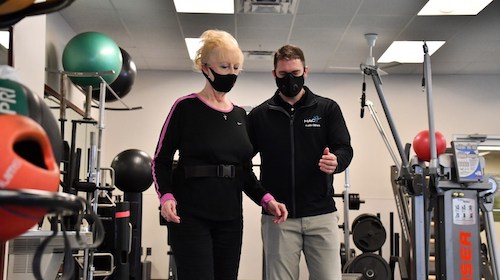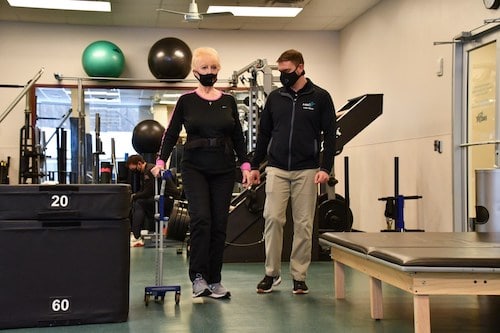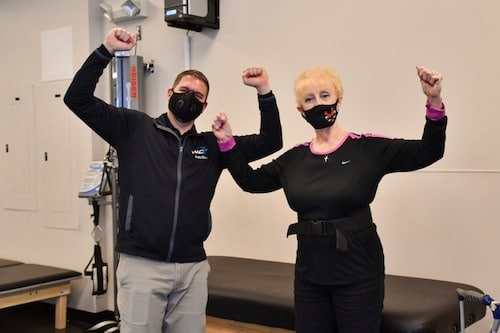On Your Feet: HAC Member Joyce Heritage Walks Independently For The First Time In Over 21 Years
This article was originally published by the Hockessin Athletic Club/Enhance Magazine, produced and published by Sasha Reddy, Graphic Designer, Hockessin Athletic Club, and is republished with permission.
It’s late on a foggy Wednesday morning. Personal training clients are performing banded walks back and forth across the studio, wrestling under heavy weights, leaping away from the floor with explosive energy, all under the watchful eyes of their trainers. Off to the edge of the room, one woman is treading quietly around the studio’s perimeter, skirting the busybodies in the center at a gradual pace. Keeping her eyes trained on her feet and the floor in front of her, Joyce Heritage devotes her full attention to every measured step she takes. Her trainer, Keith Glines, maintains a tight grip on the belt looped around Joyce’s midsection, positioned to brace and catch his client at the slightest sign of a fall. Though seemingly mundane, Joyce and Keith’s slow schlep around the room is nothing short of extraordinary. These are among the first unassisted steps that Joyce has taken in over two decades.
Joyce’s story begins during Father’s Day weekend, 1999. She and her husband John had just left a barbecue at their daughter’s house when, during the ride home, Joyce began feeling some discomfort in her legs. “I told John that I was feeling some cramps in the calves and my toes were tingling,” she says. Though the discomfort didn’t seem to be cause for alarm, by the next morning, Joyce was paralyzed from the waist down.
Joyce was quickly transported to the emergency room, where rigorous diagnostic testing began. Over the next several days, she would endure not one but two spinal tap procedures, a plasmapheresis exchange – a process by which the blood is removed and machine-cleansed – and countless other procedures. Early in the process, doctors were concerned that the paralysis would continue to spread and cautioned that she might have to be “trached and vented.” Amidst all the uncertainty and clamber as medical staff scrambled to try and solve the mystery of her sudden paralysis, Joyce remained level-headed and calm. “There was no time for emotions,” she says. But finally, answers did come.
Several days after her arrival, Joyce was diagnosed with Transverse Myelitis (TM), an inflammation of the myelin sheath of nerves around the spinal cord. In Joyce’s case, inflammation around her T12 vertebrae had caused her to become paralyzed from the waist down and her nerves to burn as if they were on fire. Though the damage to Joyce’s spine was permanent, doctors explained that she might eventually be able to walk again. “With TM, one-third get everything back, one-third get something back, and one-third get nothing back,” she remembers being told. Though TM had left her requiring the use of a wheelchair, with many months or even years of physical therapy, she could eventually be up on her feet once again, and that prospect made Joyce’s next goal crystal clear.
Just as soon as Joyce received her new wheelchair, she became determined to get out of it. After a month of “hardcore rehab,” she was able to walk 17 steps with the aid of a walker but still largely required the use of a wheelchair. A few years into physical therapy, per her doctor’s recommendation, Joyce became a member at Pike Creek Fitness to work on her mobility in the pool and get further guidance from a personal trainer. “Then I met Keith Glines, who has really almost become my adopted son at this point,” she gushes.
When they began working together around 2004, Keith had not been a trainer for long. “I was almost a little intimidated,” he admits. Transverse Myelitis is a rare diagnosis; even though Keith had several years of experience working with clients with various medical conditions, he wasn’t totally certain of the best way to conduct Joyce’s training. He started by building on some of the drills that Joyce was already doing in physical therapy, then slowly began incorporating new exercises. After Keith earned his Muscle Activation Techniques (MAT)® certification in 2008, he began to employ those skills in his sessions with Joyce, which really helped with her nerve pain. “It was mostly just analysis and experimentation,” Keith says. As far as Joyce is concerned, his help was invaluable.
Though Joyce was able to move around with the aid of a walker, she could not yet walk full-time. The lack of sensation in her legs caused her to develop drop foot in both of her feet. She’s broken each of her ankles at least once just by tripping over her toes – so she still used a wheelchair most of the time. Determined to overcome her drop foot, Joyce began to observe the way that people walk. She paid close attention to the lift and push of the heel at the beginning of each step and the cadence of the different parts of the foot striking the ground in hopes of re-learning the mechanics herself. Unfortunately, she was just physically unable to create that motion. Finally, in 2011, Joyce underwent surgery on both feet at Mercy Hospital in Baltimore to correct her drop foot. She was then fitted with medial lateral athletic supports and orthotics. The equipment allowed her to lift each foot fully and step down without dragging her toes, thus letting her finally trade in her wheelchair for a walker.
Joyce had overcome the physical hurdle that prevented her from walking, but her fear of falling still lingered. She and Keith began spending time during their sessions just walking around the personal training studio to help build back her confidence and motor skills. Joyce started by completing laps with her walker, and over time she progressed to using a rolling cane (while keeping a “death grip” on Keith’s shoulder). “Keith has been challenging me ongoingly with things that he thought I could do if I got rid of the fear of falling,” Joyce says with gratitude.
Since her initial TM diagnosis in 1999, Joyce has experienced constant searing pain from her waist down to her toes. She’d taken various medications over the years to help manage her pain but at a cost. In addition to numbing the pain, the meds dulled the already limited sensation in Joyce’s spine and legs, adding to her challenge with walking. In preparation for a procedure, Joyce replaced her normal “heavy-hitter” pain meds with CBD in October 2020. Suddenly, the sensation in her lower limbs began to return. Though not fully recovered, her awareness of the ground beneath her became clearer. “I said to John, ‘I feel more sensation through my feet and my legs.’ And then I realized, ‘Well, wait, let me see what I can do with that new signal that I’m feeling.”
After several weeks of practicing in secret at home, Joyce was ready to try walking in the personal training studio with Keith. On November 18th, 2020, with Keith hovering closely to catch her if needed, she walked around the studio all by herself. Though each step felt wide and awkward, she’d done it. Joyce and Keith snagged another personal trainer and snapped a photo together to celebrate.
During their next few sessions, Keith and Joyce continued to push her ability to walk. After that first unassisted lap, she decided that she’d first try to correct her gait by shrinking the gap between her legs. After achieving that goal, Joyce decided she would walk a lap while looking ahead rather than down at her feet. “I was totally silent like a church mouse when I would walk,” Joyce says, “‘cause I was so focused on what my feet needed to do, what my eyes needed to do…” To further push his client’s potential, Keith then challenged her to count while she was walking to try and shift her focus away from the floor in front of her. After that, they tried carrying out a conversation while doing their laps and obstacles for Joyce to walk around. Even though she had finally walked on her own for the first time in over two decades, she was still eager to keep improving.
“The cool thing about Joyce is that she’s up for anything,” Keith says. He could tell her that she was going to be strapped up and hung from the rafters, and she’d be completely open to trying it. Even during quarantine, while the world had all but stopped turning, Joyce was texting Keith regularly to let him know what exercises she’d been performing at home and ask what else he wanted her to do. “How many people took that time off and got thrown off track?” Keith says. “Not Joyce! She wasn’t letting that happen. She’s a fighter that keeps pushing herself to achieve more and more!”
The way Joyce sees it, it’s Keith who deserves the credit for her success. Though safety is always his first priority, Keith has never been one to tell her whether she is or is not ready to try a new stunt. Rather, he trusts Joyce’s gut as much as she does, and he’s always looking for ways to challenge her to improve physically. That’s what she loves about training with him.
There’s a “mind-over-matter” element to Joyce’s journey. Though she realizes that not everyone has the fortune to be able to walk again after becoming paraplegic, from personal experience and her discussions with various doctors, she’s learned that healing is, at least in part, a mental game. According to Joyce’s MRI’s, as one doctor described, there is no reason that she should be physically able to walk today. Conversely, some patients continue to require the use of a wheelchair even when their bodies appear to be able to move on their own. During the last 21 years since becoming paralyzed, Joyce never thought that she would walk independently again, but that never stopped her from picking goals and working to achieve them. “You have to keep pushing yourself,” she says. “As you step through life’s journey, believe in yourself.”








